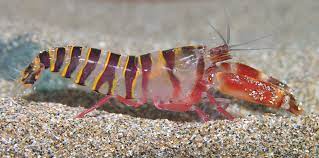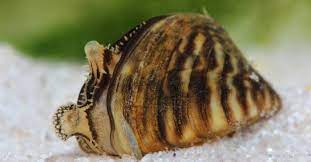While it’s certainly fascinating to observe land animals carry their homes on their back, sea creatures are certainly not to be overlooked. In fact, the number of sea animals with shells may even surpass that of their land counterparts. From pistol shrimps to clams, oysters to nautilus, the ocean is full of creatures that rely on these hard shells as protection from predators.
Table of Contents
What’s especially intriguing is how long some of these animals spend inside their shells – mollusks, for example, will happily live out their entire lives in their shells. And then there are those like oysters, which create precious pearls inside their shells. While simple presence of these protective shells reminds us of the sheer diversity and complexity of our world’s aquatic ecosystems.
List of Sea Animals With Shells
Pistol Shrimps

Scientific name: Alpheidae
The truth is that some of the first creatures that come to mind are shrimps. These tiny sea creatures have a unique exoskeleton that helps protect their delicate insides. The upper part of their shell, known as the carapace, projects forward to create the rostrum – a stiff extension that they use to defend themselves from predators and attack prey.
But there’s one type of shrimp that stands out from the crowd: the pistol shrimp. Found in tropical and subtropical waters, these creatures create impressive bubbles that jet out at high speeds, producing a pistol-like snapping sound that’s truly unique. So next time you think of animals with horns, don’t forget to include these fascinating sea creatures.
Clams

Scientific name: Bivalvia
Clams are fascinating animals with shells that are connected by two adductor muscles. These sea creatures belong to the bivalve mollusks family, which also includes oysters and scallops. To open or close their shells, clams have to contract or expand their adductor muscles.
However, not all clams look the same. Some species, like the paloverde clams, have triangular or oval-shaped shells with beautiful glossy white hues with orange or yellow tints. On the other hand, razor clams resemble old-fashioned razors. These clams have parallel-sided and elongated shells, and they usually stay buried beneath the surface to depths of about 2 feet, thus not traveling over the bottom very often.
Japanese Spider Crabs

Scientific name: Macrocheira kaempferi
While the Japanese spider crab may be a terrifying arthropod with its long spider-like legs, it has a surprising trick up its armored exoskeleton. This fascinating creature has been observed to cover its shell with sponges and other animals, shaping them with its mouth and attaching them to its carapace.
Over time, these animals become a part of the crab’s shell, effectively disguising its entire body from unwanted visitors. It’s almost as if the Japanese spider crab has its own protective suit of armor ready to defend against any potential predator. This incredible camouflage makes it no wonder that the Japanese spider crab is the largest living arthropod and crustacean, with a carapace that can grow up to a massive 16 inches wide.
Oysters

Scientific name: Ostreidae
From their incredible pearls to their beautiful shells, oysters have long been famous as delicacies and works of natural art. These saltwater bivalve mollusks come in a variety of different species, each with their own unique characteristics. The thorny or spiny oyster, for instance, possesses pointy, thorn-like protrusions all across its shell. Saddle oysters, on the other hand, have almost translucent shells that copy the shape of the object they lie upon.
Some varieties, like the windowpane oyster, even have shells that are used to make decorative objects. And of course, no discussion of oysters would be complete without mentioning the pearl oyster, whose magnificent feathers produce stunning pearls that are cherished around the world. Beautiful, intricate, and endlessly fascinating, oysters truly are some of the most amazing creatures you can find in the ocean.
American Lobsters

Scientific name: Homarus americanus
The American Lobster is a highly sought-after delicacy along the Atlantic coast in North America. Weighing from one to nine pounds, they are not only delicious but also the heaviest arthropods and crustaceans on the planet. As with all lobsters, they possess a hard exoskeleton that they shed as they grow. During this vulnerable period, many species change their color, which is fascinating to observe.
The color of American lobsters varies, and they are divided into different types based on their shell color. Blue lobsters are the most common, as they get their hue from a compound called crustaceans. Other types include red, yellow or orange, and split, while the rarest are the white lobsters or albinos. With only one in 100 million being an albino, it’s no wonder they’re considered a rare find.
Mussels

Scientific name: Mytilus
Mussels are a widely enjoyed delicacy all around the world. These bivalve mollusks have unique and elongated shells with asymmetrical features that make them stand out from other types of clams and oysters. The shells of mussels have three distinct layers that provide protection to the animal from predators and desiccation. The strong adductor muscles that join the two parts of the shell provide additional support for the soft tissues.
The inner layer of pearly mussels is made of calcium carbonate, while the middle part is composed of white crystals of calcium carbonate mixed with protein. The outer layer, known as the periostracum, is made of the protein conching and serves as a protective layer to prevent abrasion by acid dissolution. With their unique shell structure and layers, it’s no wonder that mussels are a delicacy enjoyed by many.
Krill

Scientific name: Euphausiacea
Krill, the tiny crustaceans that live in the ocean’s depths, have a special place in the aquatic ecosystem. As the main food source for many ocean carnivores, including whales, seals, and penguins, these creatures play an integral role in the survival of many marine animals. Krill’s name comes from the Norwegian term for “small fry of fish” and can grow up to 2.4 inches.
Like other crustaceans, they have a chitinous external skeleton that protects their organs. However, unlike other types of crustaceans, krill have specially evolved, unique organs within their bodies that are bioluminescent. These organs allow krill to produce light, which they use for counter-illumination camouflage and communication. It’s no wonder krill are considered one of the most important animals in the aquatic ecosystem.
Nautilus

Scientific name: Nautilidae
The nautilus is a fascinating creature that may look like a mollusk due to its hard shell, but it is actually a cephalopod. Growing to be up to 10 inches in diameter, these creatures have developed a unique defense mechanism, in which they can completely withdraw into their shell and shut themselves off. The shell is made up of two layers, an iridescent white inner layer and a somewhat matte outer layer.
But the innermost part of the shell is arguably the most beautiful, giving off a mesmerizing blue hue. A nautilus shell is pressure-resistant and only implodes at extreme depths, reaching 800 meters. With dark irregular stripes on the upper layer of their shell, they are able to blend perfectly into the dark water. The underside, on the other hand, is almost fully white, making it almost impossible for other creatures to spot in brighter underwaters.
Scallops

Scientific name: Pectinidae
Scallops, the shellfish that many people confuse with the beloved side dish, scalloped potatoes, are an extraordinary bivalve mollusk. Their streamlined shells grant these creatures superior mobility and the ability to evade predators with ease. Interestingly, scallops have two valves, one on the right and one on the left, and they usually rest on their right valve, giving it a more rounded appearance.
Unlike most bivalves, scallops have a comb-like structure called ctenolium adorning the anterior edge of the right valve. Although it disappears after maturation, this unique feature is a sight to behold. Moreover, scallops have a single adductor muscle inside their shells, similar to oysters, which is much more developed due to their active swimming. These exotic delicacies thrive in oceans worldwide, especially in the Indo-Pacific waters.
Chitons

Scientific name: Polyplacophora
Chitons are fascinating marine mollusks that inhabit the coasts. The oval-shaped creatures feature large flat feet for clinging to rocks and creeping over the sea floors. Despite their snail-like appearance, chitons’ upper shell comprises eight separate valves that slightly overlap and interlock at the front and back edges. The muscular girdle encircling the shell plates offers additional protection.
Interestingly, a chiton’s shell not only protects them from predators, but it also allows them to move freely and flex upwards while in motion. With over 600 species found worldwide, these incredible organisms exhibit a wide range of shells, including different colors, patterns and textures. Whether small or almost as big as a human foot, if dislodged or disturbed from rocks, they roll into a ball like woodlice.
Barnacles

Scientific name: Cirripedia
Barnacles might not be as famous as other sea creatures, but they hold their own unique charm. With their distinct appearance and ability to cling onto live symbionts, they are truly fascinating. Starting their lives as free-swimming larvae with crustacean traits, they eventually attach themselves to surrounding substrates with cement glands.
From there, they grow their shells directly on their substrate or use the ring of calcified plates that surround their body, which have the ability to fuse solidly depending on the species. Though they might not be mobile, their modified legs allow them to reach out for food in the water, spending most of their time attached to the bottom of boats, rocks, and other hard surfaces. Despite their unconventional life, barnacles prove to be an important member of sea animal life.
FAQs
Which sea animal has a shell?
Clams, oysters and scallops.
What are 4 animals that have shells?
Crab, prawn, lobsters and snails.
What aquatic animals have shells on their bodies?
Clams, oysters, snails, mussels, and scallops.
Final Words
The world beneath the sea is not just home to a diverse range of sea animals but also houses some of the most strikingly beautiful creatures. One such group of creatures is the sea animals with shells. The vivid colors, unique shapes, and diverse sizes of these animals are simply breathtaking. Some are even shimmering and translucent, adding an otherworldly feel to their already fascinating appearance.
But their beauty is not the only thing remarkable about them as they also produce precious materials like pearls. These mollusks and crustaceans are not just a feast for the eyes, but also for the stomach, with many people consuming them around the world. Our list has highlighted most of the prominent shell-bearing sea animals, but we’re always looking to enhance our knowledge.
Reference:
- https://www.dnr.sc.gov/marine/sertc/what-lives-in-shell-lesson-plan.pdf
- https://opjsrgh.in/Content/Worksheet/PRACTICE-WS/day80/3-EVS.pdf
- https://diveintolife.blog/what-animals-live-in-seashells-southern-california/
A motivated philosophy graduate and student of wildlife conservation with a deep interest in human-wildlife relationships, including wildlife communication, environmental education, and conservation anthropology. Offers strong interpersonal, research, writing, and creativity skills.










